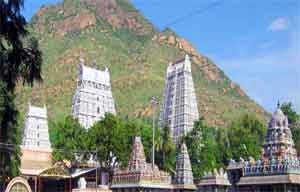
Girivalam
The Holy Mountain of Arunachala rises up with an elevation of 2669 feet (800 m). The Road encircling the mountain where devotees circumbulate is 8 1/2 miles which is 14 kms long. On Full Moon days and festival days (like Karthigai, first day of the Tamil month, Tamil New Year day) hundreds of thousands of devotees circumbulate (GIRIVALAM) the mountain and get the blessings of the Lord Arunachala.
Though devoid of vegetation the hill stands in prominence amidst picturesque surroundings and is visible for miles around. This hill is of Igneous rock (connected with fire) which is one of the four kinds of mountains classified by geology. So one sees the truth behind the tradition regarding the origin and formation of this hill. Our religious philosophy is based on science and there is always the combination of Vignana and Meygnana. These two are inextricably intertwined. An American Geologist has stated about this mountain thus:- "Arunachala should have been thrown up by the earth under the stress of some violent volcanic eruption in the dim ages before even the coal-bearing strata were formed.
This rocky mass of granite may be dated back to the earliest epoch of the history of our planet's crust, that epoch which long preceded the vast sedimentary formation in which fossil records of plants and animals have been preserved. It existed long before the gigantic saurians of the pre-historic world moved their ungainly forms through the primeval forests that covered our early earth. It was contemporaneous with the formation of the very crust of earth itself. Arunachala was almost as hoary and as ancient as our planetary home itself"." It was indeed a remnant of the vanished continent (Kumarikandam) of Eunken Lemuria, of which the indigenous legends still keep a few memories. The Tamil traditions not only speak of the vast antiquity of this and other hills, but assert that Himalayas were not thrown up till later. Untold centuries, therefore, pressed their weight upon this time defying pile which arose so abruptly from the plains. The whole peck offers no pretty panorama of regular outline, straight sides and balanced proportions, but rather the reverse. Even its base wanders aimlessly about an eight mile circuit, with several spurs and foot hills, as though unable to make up its mind as to when it shall come to an end. Its substance is nothing but igneous and laterise rock". What a miracle! Such a barren rock has captivated the souls of sages and saints for ages together.
Legends say that Tiruvannamalai was a fire (Agni) mountain in Krathayuga, Gold (Swarna) mountain in Thrathayugha, Copper (Thambra) mountain in Duvaparayuga and rock mountain in this Kaliyuga.
Arunachala hill has a high status in our sacred tradition and Tamil legends hold that it is far more ancient than the Himalayas which are comparatively known to be of later origin. Arunachala is a combination of two Sanskrit words Aruna and Achala. Aruna means 'red' and Achala means ' immovable' mount, there by known as "Red Mount". It is also called the "Hill of the Holy Beacon" and "Hill of the Holy Fire". The philosophers would give another interpretation for the word Arunachala. Aruna is force(Sakthi) and Achala is Shiva i.e. that which cannot be moved. The Hill therefore represents Shiva and Parvathi. There is still another interpretation Aruna means "Free from Bondage" and Achala means "motionless, steady". The true inner meaning of the word is that one can attain salvation only by concentration on God free from wordly bondage. The popular Tamil name is "Annamalai" which is also a combination of two words 'Anna' and 'malai'. Anna or "attained" and malai means hill. This denotes the story of dispute between Brahma and Vishnu and the philosophic truth behind it. From an inscription in the temple and from the Sanskrit work "Sahitya Retnakara" it is seen that the hill is called as Sonachala(Red Mount). The hill is regarded as Tejo linga(the fire symbol of God) or Jothi linga. It stands at the rear end of the town and the temple is at the foot of the hill.